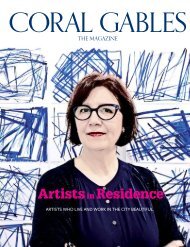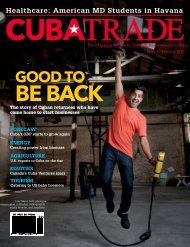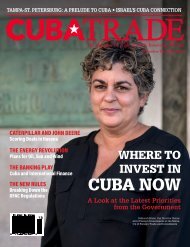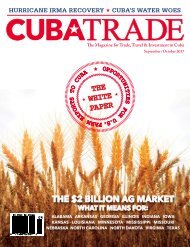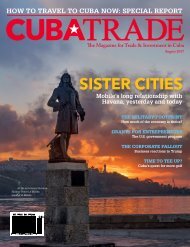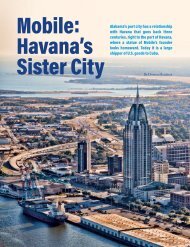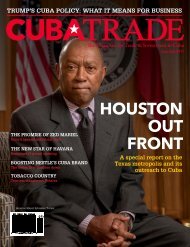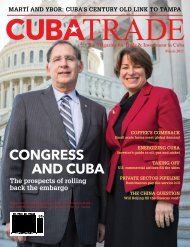CubaTrade-April2017-FLIPBOOK
Create successful ePaper yourself
Turn your PDF publications into a flip-book with our unique Google optimized e-Paper software.
"From Aachen to Zurich” (2005) depicts the word Revolución in changing typographies<br />
“Untitled” (2013) by Alejandro Rodríguez Falcón<br />
Russian military-style posters at the installation of Adios Utopia<br />
The museum had not yet opened and there was already<br />
a line of people all the way to the corner. It was a rainy<br />
Sunday in March, and the exhibit “Adios Utopia: Dreams<br />
and Deception in Cuban Art since 1950” was opening to the<br />
public at Houston’s Museum of Fine Arts (MFAH).<br />
From the museum’s second floor, huge panels depicting heroic<br />
images with Russian lettering ushered visitors into what might<br />
have been an homage to a bygone dream world, the revolutionary<br />
utopia. What followed, however, was not the evidence of a failed<br />
project, but a testament to the creative experimentation made<br />
possible by revolutionary socialism—even if in spite of itself.<br />
Adios Utopia is ambitious. Organized by the Cisneros Fontanals<br />
Foundation (CIFO), in partnership with the MFAH and<br />
the Walker Art Center in Minneapolis, it is co-curated by René<br />
Francisco, Gerardo Mosquera and Elsa Vega, all distinguished<br />
scholars, critics and curators. It is probably the most comprehensive<br />
exhibition of post-revolutionary Cuban art ever undertaken.<br />
It is not, however, a chronological retrospective. Rather, it responds<br />
to a thesis: Artistic experimentation was intrinsic to a revolution<br />
that was, first and foremost, ideological. Even as it pushed<br />
the limits marked by Fidel Castro’s guiding motto, “Within the<br />
Revolution, everything; against the Revolution, nothing,” art was<br />
meant not to merely interpret reality, but to remake it.<br />
The exhibit spans the last six decades, with works familiar<br />
to connoisseurs but unknown to the general public. It includes<br />
photojournalism as well as poster art and comic strips that were<br />
central to a revolutionary project that sought to make culture<br />
available to the masses.<br />
That raw zeal is apparent; it was more than a quarter century<br />
after the Revolution before the Instituto Superior de Arte (ISA)<br />
was founded for the professionalization of contemporary artists.<br />
But by the time the first cohort graduated, the crisis of the Mariel<br />
boatlift had left behind a general disenchantment that produced<br />
the most critical art in recent memory. This well-educated elite<br />
became at once the Revolution’s source of pride and failure. The<br />
New Man was not a yes-man.<br />
Adios Utopia only loosely follows a time line. It is instead<br />
structured around recurrent preoccupations, both in terms of artistic<br />
form and of the artists’ critical gaze. The marvel of pre-revolutionary<br />
abstraction that sought to speak in a universal language<br />
is soon silenced by the euphoria of the epic sixties. Photojournalism,<br />
poster art, and comic strips served the state’s merger of art<br />
and ideology in the service of a political project.<br />
Later this popular art was deconstructed by Cuba’s newly<br />
educated artists. In the museum, a heroic image like Korda’s Che<br />
is pointedly placed in dialogue with its subversions, including<br />
Tomás Esson’s painting of a mute Ché watching a scatological<br />
act (“My Homage to Che,”1987) and Arturo Cuenca’s photograph<br />
of the supporting structure to a gigantic Che billboard<br />
(“Science and Ideology: Che,” 1987-88).<br />
Similarly, in a section on revolutionary rhetoric, works seek to<br />
divert the viewer’s attention from content to form. Ernesto Oro-<br />
za’s animation “From Aachen to Zurich” (2005) flashes the term<br />
“Revolution” with changing typographies, as if to strip the term<br />
from its aura, while contributing to its overwhelming presence.<br />
In another section, devoted to what playwright Virginio<br />
Piñera called the “damned circumstance of water everywhere,”<br />
artists ponder the twin conditions of island and exile. The<br />
exhibit’s own farewell is “Inverted Utopias,” comprising works<br />
that challenge that “within” of the Revolution by exposing both<br />
ideology and the critiques that have worked to reinforce it.<br />
Among all these works, one that is small, understated, and<br />
as white as the wall behind it, can be seen as a powerful synthesis<br />
of this proclaimed post-utopian turn in Cuban art. It is a scruffy<br />
square volume of what appears to be paper pulp, still revealing<br />
fragments of words and ink: “Untitled” (2013), by Alejandro<br />
Rodríguez Falcón. Through a manual process of paper recycling,<br />
Rodríguez reduced an official pocket-sized copy of the 1976 Cuban<br />
Constitution—its first socialist Constitution—to wet paper.<br />
In so doing, it turned it into a unique art object.<br />
Like Ai Wei Wei’s famous smashing of archaeological vases,<br />
Rodriguez’s iconoclastic gesture is the art’s genesis. He degrades<br />
the most valuable symbol of the nation, its foundational document,<br />
the revolutionary state’s own contract with its citizens, in<br />
an act of wishful thinking. Then, it carefully displays it behind<br />
glass and inside an oversized frame, as a precious object whose<br />
value no longer resides in its content but in its bare materiality.<br />
Unlike Wei Wei, Rodríguez does not claim the capitalist<br />
market as the arbitrator of value. His might be the kind of act<br />
that in 1990 cost another artist, Angel Delgado, prison time<br />
when he defecated on a Granma newspaper. Today, however,<br />
the Constitution’s defacement hardly produces scandal. Instead,<br />
we squint at the nicely framed volume and celebrate the clever<br />
aesthetics of the transmuted object, whose destruction we were<br />
not invited to witness.<br />
If the museum is the place for salvaged relics, the Cuban<br />
Constitution is there before its time. The Constitution’s power<br />
exceeds its matter; and it still rules the law in the land, unthreatened<br />
by the artist’s act. Which begs the question: Has art, like<br />
the Revolution itself, lost its power to shock and awe, or at least<br />
provoke the imagining of another world?<br />
We know one thing: They no longer need each other, and the<br />
very organization of Adios Utopia proves this point. Cuban state<br />
institutions did not participate, and the artworks were selected<br />
from private collections and museums outside Cuba, apparently<br />
to prevent bureaucratic impediments at an uncertain time in<br />
U.S.-Cuba relations.<br />
One has to wonder if an adios to utopia is not a farewell to<br />
art itself—and hope that this is just a momentary surrender. H<br />
““Adiós Utopia: Dreams and Deceptions in Cuban Art Since 1950” is accompanied<br />
by a catalog coordinated by CIFO’s chief curator Eugenio Valdés Figueroa.<br />
The exhibit is on view through May 21 at the Museum of Fine Arts, Houston.<br />
90 CUBATRADE APRIL 2017<br />
APRIL 2017 CUBATRADE<br />
91



